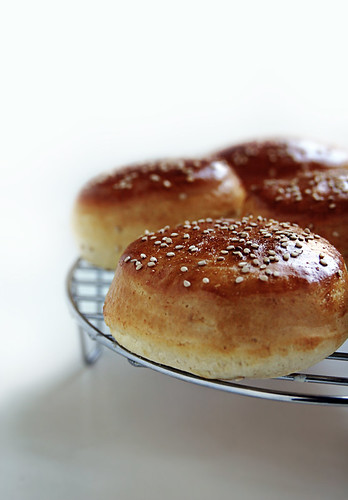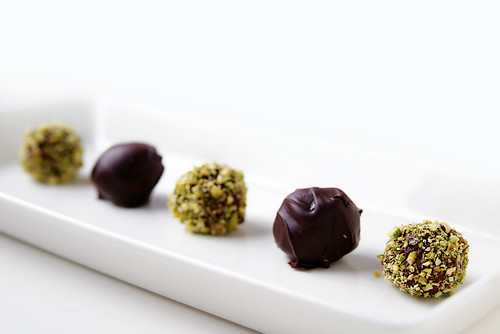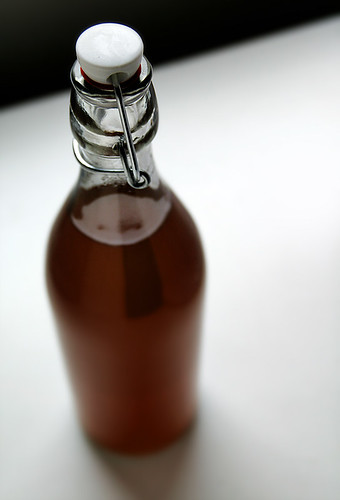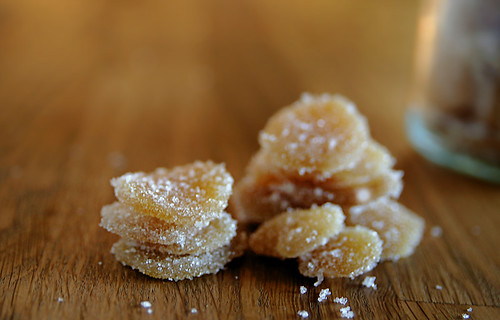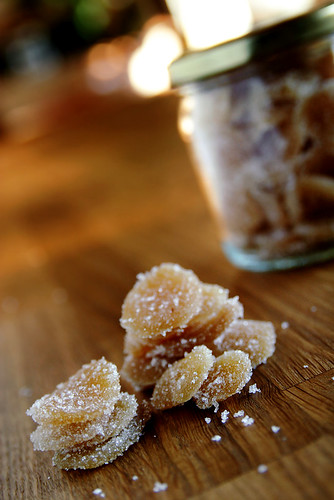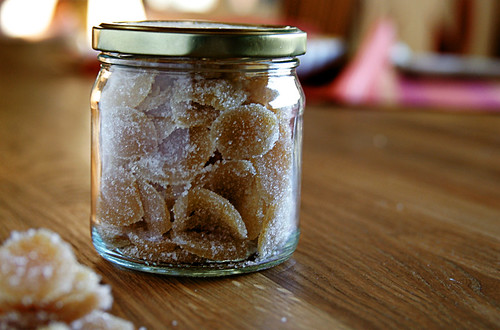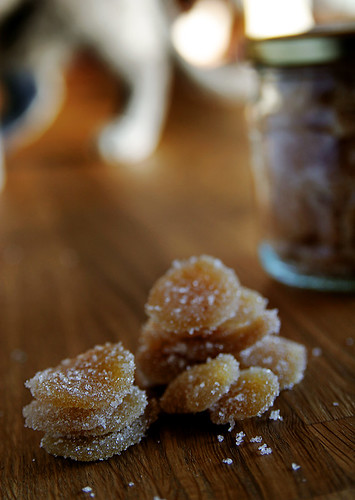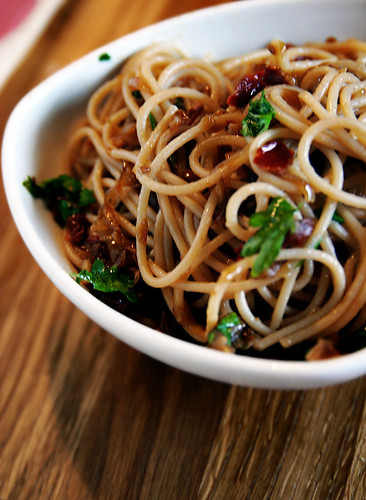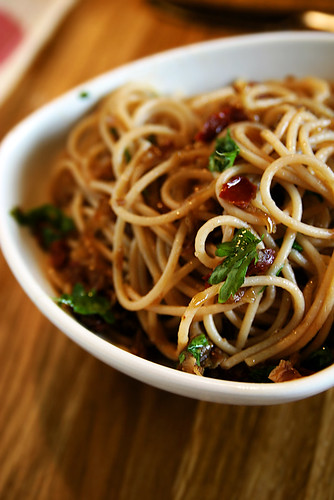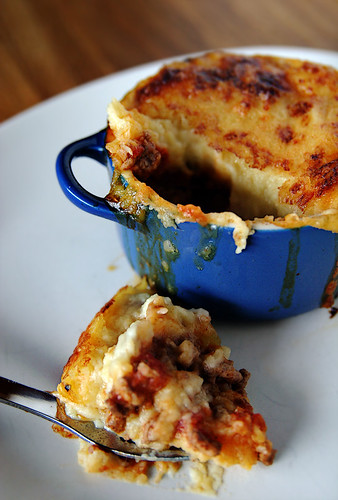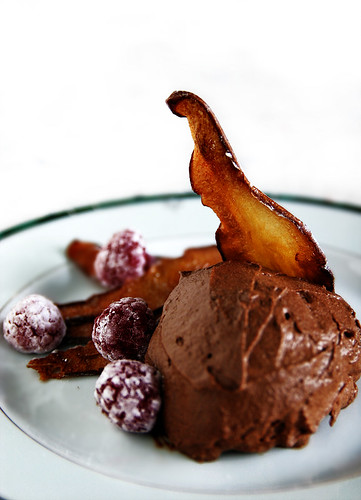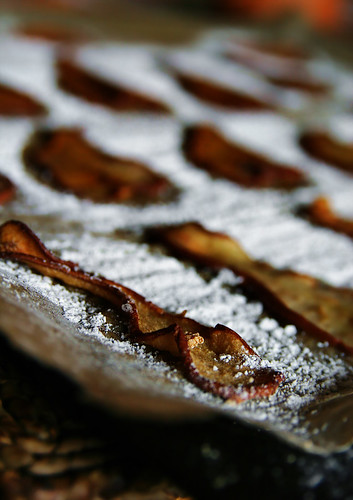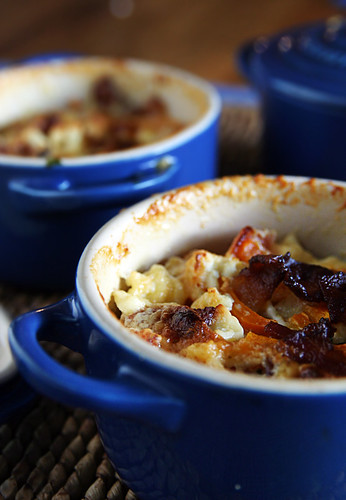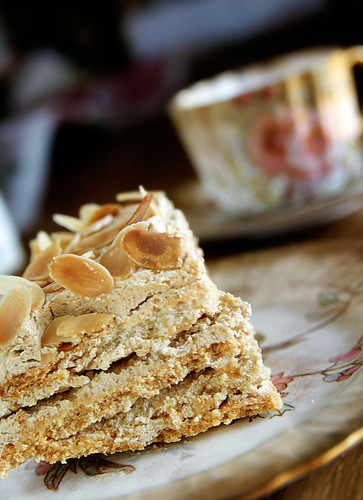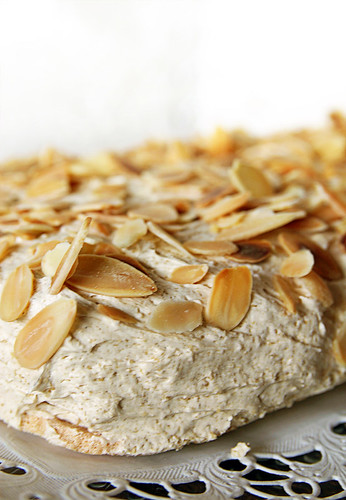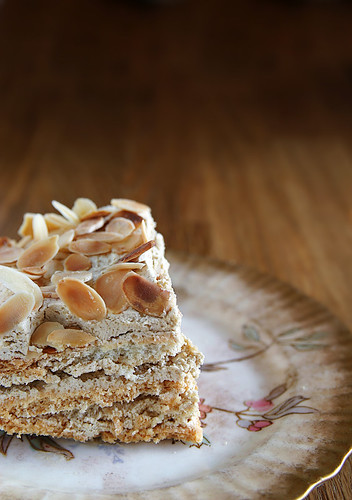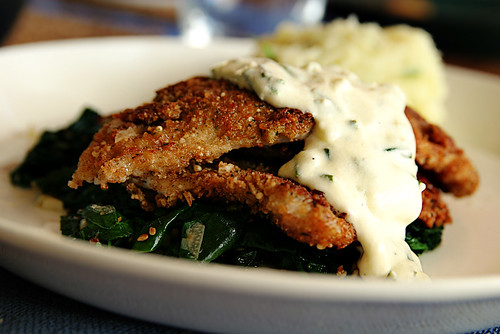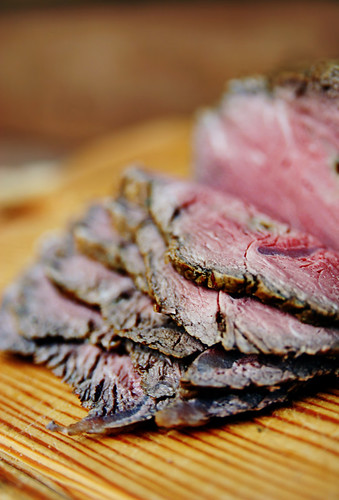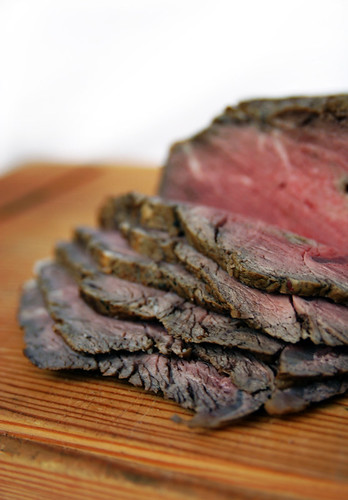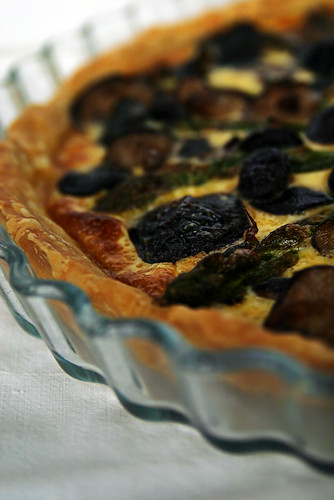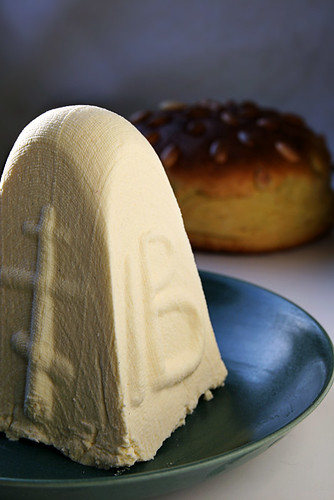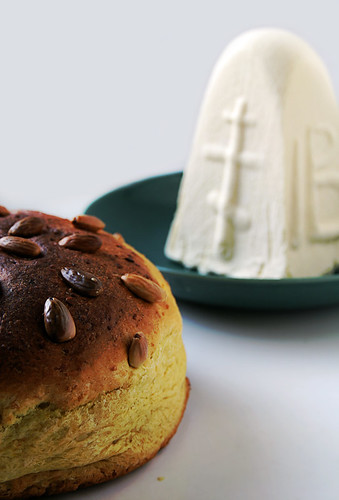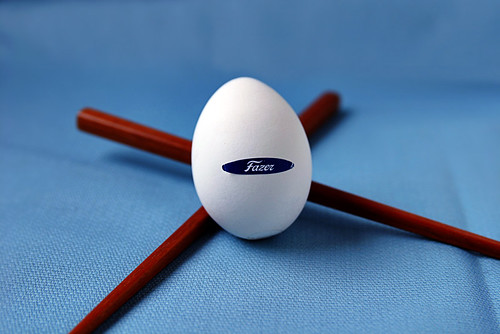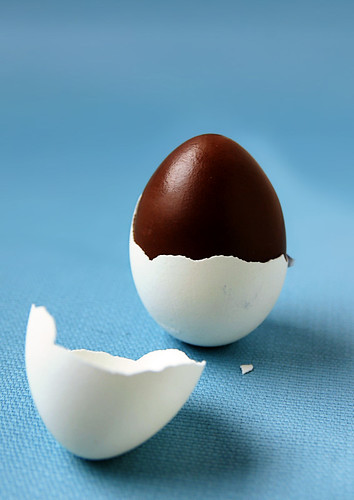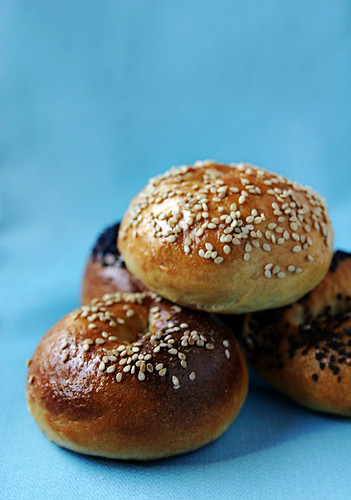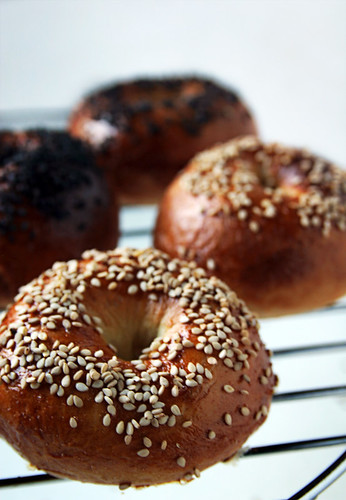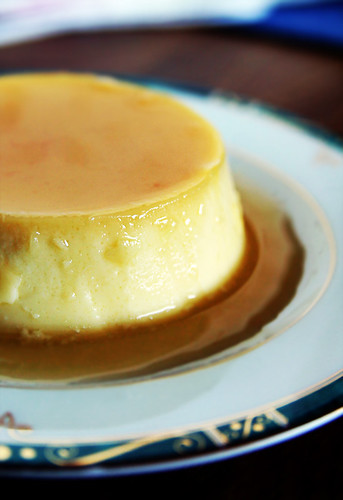I'm at the speaking in tongues thing again, this time for the Swedish food blog event Cyberkocken (check out the roundup here). Writeup and recipe in English below.
Så var det då dags att försöka blogga om mat på det andra inhemska (som visserligen är det första för mig, men ändå - jag har blivit van vid att både skriva om och tänka på mat mest på engelska, bisarrt nog).
Ingredienserna till
Cyberkocken var ju då citron, chorizo, kronärtsskocka och bröd. (Se alla bidrag
här.) Färsk kronärtsskocka hittade inte jag (har faktiskt ingen aning om när det är säsong) så tanken på en gräddig, chorizospäckad gratäng fick jag begrava redan i startgroparna. Samtidigt var det ett tag sen jag rostade höna, faktiskt var det före jag började matblogga här, så då kom det ju sig naturligt att (istället för att hitta på ett
riktigt recept) bara blanda ihop alltihop i en fyllning till en (eller i det här fallet två; brodern min var tillväntad till söndagslunch och honom får man reservera gott om kött åt) höna och sedan bara slänga hela härvan i ugnen. Eller?
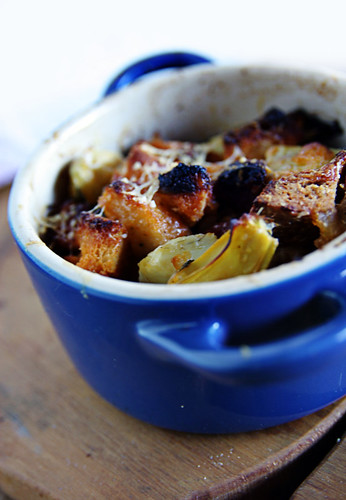
I praktiken satt jag sen där med en hel massa fyllning (jag brukar kalla det
stuffing vid julbordet och få förebrående blickar från den
äldre mer språkvårdande generationen) som inte rymdes i hönan, men kom på att i *host* salmonellahysteriska trakter så tillreds
stuffingen (hjälp! kan inte tänka på det med rätta namnet!) ofta separat. Så då blev det diverse små formar i ugnen också.
Att rosta kyckling/höna i ugnen är lätt som en plätt, det var det ingen som berättade åt mig före jag själv, med stor bävan, försökte mig på en av Nigellas allra simplaste versioner. Fortfarande räknar jag ut stektiderna enligt tabellen i
How to Eat: 30 minuter i 200°C + 20 minuter för varje halvkilo. Har man fyllning med skall vikten av den räknas med, och även så gäller det att inte packa den för tätt. Men annars är det inget att vara rädd för (så länge själva fågeln man får tag på är någorlunda saftig) och framförallt ser det
väldigt imponerande ut. Vilket man nog inte kan säga om fyllningen själv.
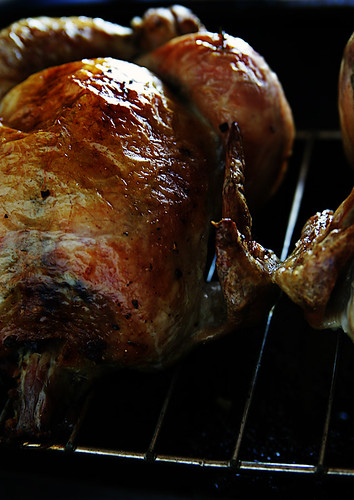 To recap in English:Cyberkocken
To recap in English:Cyberkocken is the Swedish equivalent to the Paper Chef event - you get a certain number of ingredients and prepare a meal or dish using all of them. This time the ingredients were lemon, chorizo, artichoke and bread. I'd been dreaming of a chorizo-specked creamy artichoke gratin, but couldn't find fresh artichoke so I guess I'll have to keep on dreaming for a while. In the meantime it had been a while since I last roasted a chicken, so instead of actually coming up with a recipe, I threw all the ingredients together for a stuffing.
In fact, I got a little bit carried away and wound up with way more stuffing than I actually needed. Luckily salmonella fears have taught me that stuffing
should can be prepared separately, so the leftovers went into these lovely new cocottes.
The great thing about a roasted chicken is that it looks pretty. And more complicated than it is - the first time I roasted one whole I couldn't imagine winding up with anything other than a complete mess on my hands, but no, it's really easy and fairly foolproof. My formula for roasting times comes from Nigella Lawson's How to Eat - 30 minutes at 200°C/400°F + 20 minutes for every pound (500 g).
Rostad höna med chorizo & kronärtsskocka
1.5 liter brödtärningar
225 g riktigt stark chorizo, också den tärnad
1 msk olja
1 lök, skivad
4 vitlöksklyftor, hackade
2 burkar kronärtsskockshjärtan (det skulle säkert gå fint med färsk också), sköljda ock skurna i bitar
färska örter (själv hade jag bara persilja, men det gick helt bra)
2 dl hönsbuljong
1 msk torr sherry
1 citron
1 (eller 2) hel kyckling
salt & peppar
Toasta brödtärningarna lätt i en 150-gradig ugn (skaka om då och då) - ca 20 minuter.
Fräs löken och vitlöken i oljan (med chorizon om den är rå och inte rökt som min) tills de är mjuka, blanda i kronärtsskockan och örterna (och chorizon). Rör om tills allt är varmt. Just före du skall stoppa i fyllningen blandar du i brödet och en slurk hönsbuljong med sherryn iblandad. Peppra enligt smak.
Värm ugnen till 200°C. Skölj och torka fågeln och nyp bort ev. fjäderrester (uck). Salta och peppra både ytan och innanmätet, fyll på med så mycket av fyllningen som ryms. Peta in citronskivor under skinnet på bröstet (eller släng i dem tillsammans med fyllningen - under skinnet ger mer smak tycker jag men det blir såklart mindre vackert). Gnid in lite olivolja i skinnet och bind eventuellt upp vingarna. Stek på galler (eh, med en ugnsform under, såklart) i 30 minuter + 20 min för varje 500 g, pensla ytan med lite hönsbuljong några gånger under stekningen.
Resten av fyllningen häller du i en smord ugnsform (eller flera - det kanske bara är jag som har fnatt på portionsformar men i det här fallet var det också praktiskt för en större form hade nog inte rymts i ugnen) och steker täckt med lock eller folie i ungefär en kvart och sedan otäckt (hrm) en kvart eller så till, tills ytan blir vackert krispig. Att sätta in formen ca 20 minuter före hönan skall vara färdig borde fungera bra, för den kan gärna sitta kvar i ugnen en stund medan hönan vilar på skärbrädet.
Hur man vackert skär upp en höna får ni lista ut själva, för det kan inte jag.
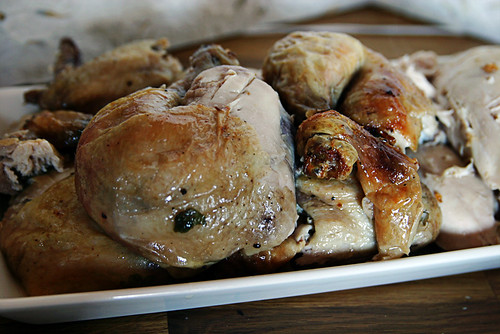
Chorizo and Artichoke-Stuffed Roast Chicken
1.5 l (6 cups) breadcubes
225 g (½ lb) chorizo, cubed
1 tbsp olive oil
2 medium onions, chopped
4 cloves garlic, minced
2 cans artichoke hearts, drained, rinsed and cubed
fresh herbs (I used parsley)
200 ml chicken stock
1 tbsp dry sherry
1 lemon
1 (or in this case, 2) chicken
salt & pepper
Toast the breadcubes in a 150°C oven for about 20 minutes, stirring a few times during baking. Soften the onions and garlic in the olive oil (together with the chorizo if it's raw), then add herbs and artichoke hearts (and chorizo) and stir until it's heated through. Just before stuffing the bird(s), mix in the bread cubes and a splosh of sherried chicken stock. Add pepper to taste.
Clean and dry the birds and salt and pepper inside and out. Add some stuffing to the inner cavities and lemon slices either together with the stuffing or pushed in under the skin on the breasts of the chicken.
Roast at 200°C for 30 minutes + 20 minutes for every pound (500 g), basting with the remaining chicken stock a few times during roasting.
Pour the rest of the stuffing into one or several greased oven-proof bowls and bake, covered, for about 15 minutes, and then uncovered another 15 minutes or until crisp on the surface.

